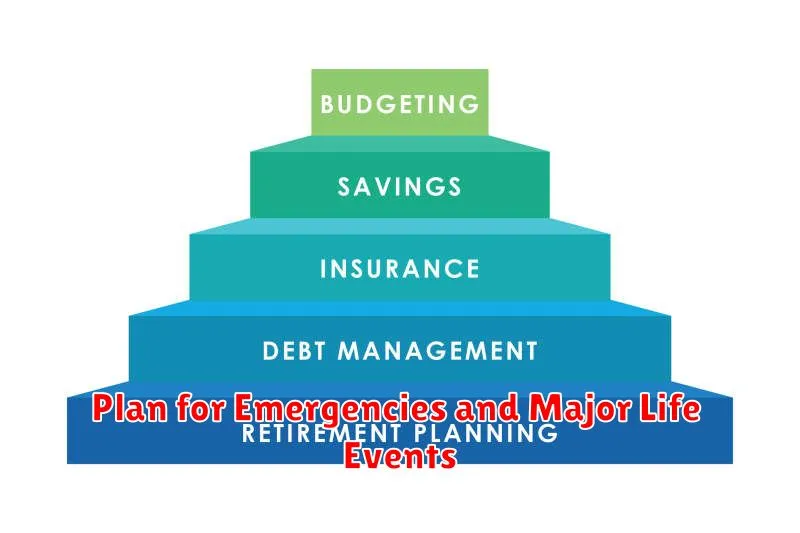In today’s ever-changing economic landscape, having a financial plan is not just a plus, it’s an essential part of achieving long-term stability and success. Whether you are just starting your financial journey or seeking to enhance your current strategy, understanding how to create a simple and effective financial plan can be a game-changer. This guide will walk you through the critical steps, utilizing proven techniques and insights to help you navigate your financial future with confidence and clarity. Learn how to prioritize your financial goals, manage risks, and allocate resources efficiently to secure a stable and prosperous financial future.
Why You Need a Financial Plan at Any Age
Having a financial plan is essential regardless of your age. Whether you are just starting your career, managing a growing family, or approaching retirement, a well-structured financial strategy provides a strong foundation for achieving your goals.
For young adults, a financial plan helps establish early saving habits and sets the stage for future financial security. It empowers them to manage student loan debts, save for major purchases like a house, and plan for unforeseen expenses.
In middle age, financial planning is critical for balancing multiple financial responsibilities such as paying off a mortgage, funding children’s education, and building retirement savings. A clear plan ensures that these goals are met without compromising lifestyle choices.
For those approaching retirement, a financial plan becomes a crucial tool to ensure a comfortable and secure retirement. It helps in managing investments, understanding healthcare costs, and maintaining the desired standard of living post-retirement.
No matter your life stage, having a financial plan helps in making informed decisions, reducing financial stress, and ensuring that monetary resources are effectively utilized to reach both short-term and long-term objectives.
Assess Your Current Income and Expenses
Creating a financial plan begins with a clear understanding of your current income and expenses. This involves evaluating all sources of income, including your salary, benefits, bonuses, and any side income you might have. Summing up these sources will give you a comprehensive view of your total monthly or annual income.
Next, list your monthly expenses. Include both fixed expenses, such as rent, utilities, and loan payments, and variable expenses like groceries, entertainment, and travel. It might help to review past bank statements or use budgeting apps to ensure you account for everything.
Subtract your total expenses from your total income to determine your net cash flow. A positive number indicates you are living within your means, while a negative number suggests you need to curb spending or boost income. Accurate assessment sets the stage for making informed financial decisions and building a robust financial plan.
Set Clear Objectives for the Next 1–5 Years
Establishing clear objectives for the next 1-5 years is the cornerstone of any effective financial plan. It enables you to chart a course that is aligned with your aspirations and priorities. Begin by identifying your financial goals, whether they involve purchasing a home, saving for retirement, or eliminating debt. Ensure these goals are specific, measurable, and achievable.
Once you have delineated your objectives, incorporate them into a timeline that helps prioritize immediate needs while considering long-term aspirations. This timeline serves as a roadmap, guiding your financial decisions and helping allocate resources more effectively. Understanding the time horizon for each goal aids in choosing suitable financial instruments and strategies.
Throughout the planning period, regularly review and adjust your objectives to reflect changes in your circumstances or financial landscape. This ensures that your financial plan remains relevant and responsive to your evolving life situations. By setting clear and concise objectives, you lay a solid foundation for a successful financial future.
Plan for Emergencies and Major Life Events

Setting aside a fund for emergencies and major life events is a crucial component of any financial plan. These events can range from unexpected medical expenses to significant life changes like marriage, buying a house, or welcoming a new family member.
Begin by identifying potential events that might impact your financial stability. List and categorize them according to their likelihood and potential financial impact. This will help you prioritize which events to prepare for first.
Next, establish an emergency fund. Aim to save enough to cover three to six months’ worth of living expenses. This provides a financial cushion that can help you manage unforeseen circumstances without derailing your long-term financial goals.
For upcoming major life events, plan ahead by estimating costs and setting savings targets. Make a timeline that aligns your savings strategy with the anticipated timing of these events.
Regularly review and adjust your plans to ensure they align with changing circumstances and your overall financial health. Consistent monitoring and flexibility can cushion the blow of emergencies and life transitions, providing peace of mind and financial stability.
Include Debt Repayment in Your Strategy
When crafting a financial plan, addressing existing debts is crucial for ensuring long-term financial health. Incorporating a robust debt repayment strategy not only alleviates financial burdens but also frees up resources for future investments and goals.
Begin by listing all outstanding debts, including credit card balances, student loans, and personal loans. Prioritize these based on interest rates, with higher rates requiring more immediate attention to reduce accumulating costs. This approach, often termed the “avalanche method”, saves money in the long run.
Alternatively, the “snowball method” focuses on paying off the smallest debts first, which can provide psychological boosts and build momentum. Choose the strategy that best aligns with your financial situation and personal motivation.
Commit to a consistent repayment schedule, even if it requires adjusting other parts of your budget. By making debt repayment a key component of your financial strategy, you achieve greater financial freedom and put yourself on a path to better manage your finances.
Incorporate Saving and Investing Goals
Developing a financial plan requires identifying and integrating both saving and investing goals. These goals serve as the foundation for achieving financial stability and growth.
First, establish short-term and long-term savings targets. Short-term goals might include building an emergency fund or saving for a vacation, while long-term goals can focus on retirement or college funds. Outline specific amounts and deadlines to maintain focus and motivation.
Next, determine your investment strategy based on risk tolerance and time horizon. Diversifying investments across different asset classes is vital to minimize risks and maximize returns. Consider consulting with a financial advisor for personalized advice.
Regularly review and adjust your saving and investing goals to reflect changes in income, expenses, or life circumstances. This ensures you remain on track and can adapt to unforeseen events.
By incorporating saving and investing goals into your financial plan, you create a robust framework that supports both present financial needs and future aspirations, ultimately leading to a more secure financial future.
Monitor Your Cash Flow Monthly
Effectively managing your cash flow is a fundamental aspect of maintaining a healthy financial plan. By closely monitoring your cash flow on a monthly basis, you can gain comprehensive insights into your income and expenditures, enabling better financial decisions.
Start by reviewing all sources of income for the month, including salaries, dividends, and any other revenue streams. It is crucial to ensure you’re aware of how much money is coming in regularly.
Next, document every expense, from fixed expenses like rent and utilities to variable ones like groceries and entertainment. This helps in identifying spending patterns and understanding where you might be able to cut unnecessary costs.
After consolidating your income and expenses, calculate your net cash flow by subtracting total expenses from total income. A positive net cash flow indicates a surplus, which you might consider saving or investing, while a negative cash flow suggests a need to reassess and possibly adjust your spending habits.
Commit to a monthly review to keep your finances aligned with your goals. Regular monitoring allows for early detection of any financial anomalies and helps ensure you’re on track to achieving your financial objectives.
Consult a Financial Advisor If Needed
Creating a financial plan can sometimes be daunting, especially if you’re unfamiliar with financial concepts or your financial situation is complex. In such cases, consulting a financial advisor can be a wise decision.
A financial advisor can provide expert guidance tailored to your specific financial goals and needs. They have the experience and knowledge to help you navigate through the complexities of financial planning, ensuring that your plan is not only effective but also sustainable in the long term.
When selecting a financial advisor, it’s crucial to choose someone who is certified and has a good reputation. You can verify their credentials and ask for recommendations to ensure they align with your financial interests.
In conclusion, while a DIY approach to financial planning is suitable for some, others may greatly benefit from professional advice. If you find yourself confused or overwhelmed, don’t hesitate to seek out a financial advisor. Their expertise can be indispensable in achieving your financial objectives and securing your financial future.
Keep Your Plan Flexible and Adaptable
In creating a financial plan, it is crucial to ensure that it remains flexible and adaptable. The financial landscape is continuously evolving, and unexpected changes can occur, affecting your financial goals and objectives.
One way to maintain flexibility is to regularly review and update your financial plan. Set periodic assessments to determine whether your plan aligns with current realities and needs. This could involve adjusting your savings goals, reallocating investment portfolios, or reassessing your budget based on lifestyle changes or unforeseen expenses.
Additionally, having a portion of your investments in liquid assets can provide the needed adaptability. This makes it easier to respond to changes without causing significant disruptions to your financial stability.
Embracing an adaptable mindset allows you to handle changes proactively rather than reactively. Being open to modifying your plans enhances your capacity to achieve long-term financial success regardless of economic fluctuations.

